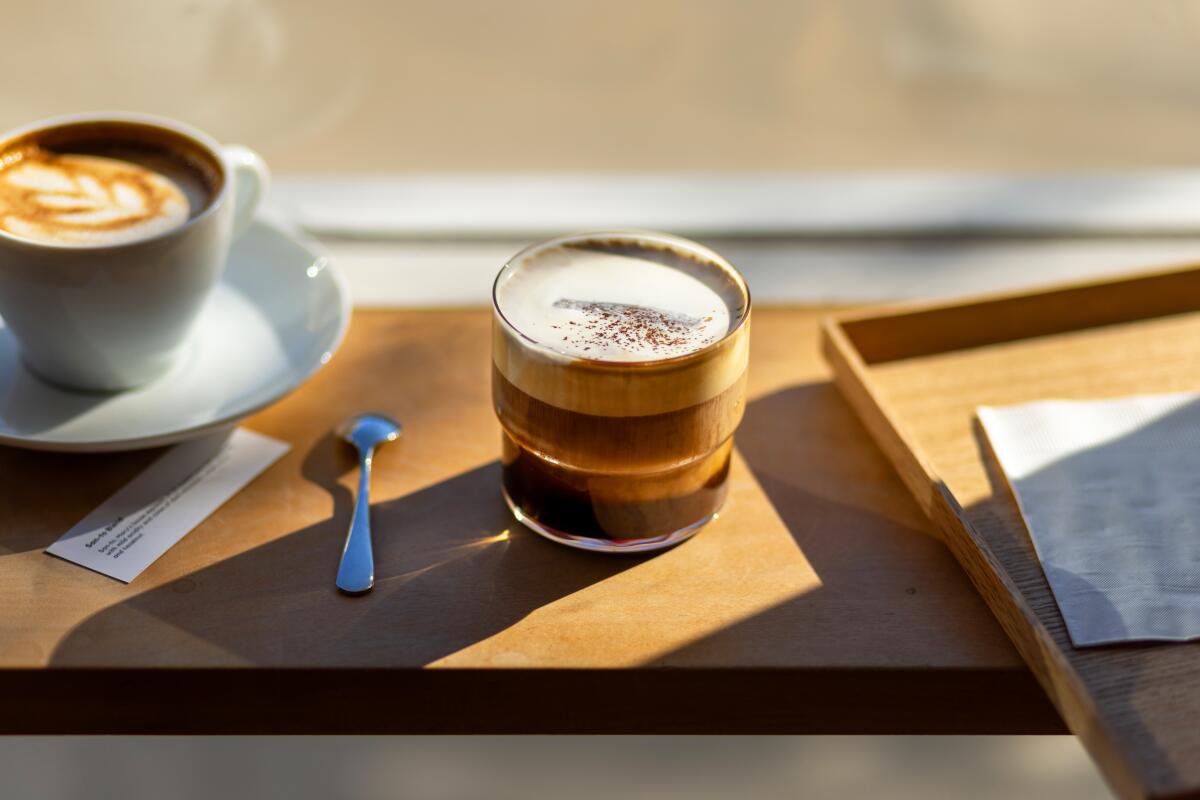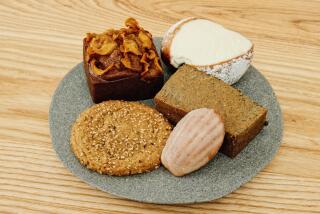Has the L.A. coffee scene reached peak cream top?

- Share via
- Maru Coffee and Mandarin Coffee Stand recently removed cream top add-ons from their menus.
- Originally inspired by Austrian Einspänner coffee drinks that took over Seoul’s coffee scene before landing in L.A., one owner says, “It just went a little bit out of control.”
Luscious, fluffy and often garnished with cocoa powder or a few carefully placed coffee beans, the cream top has become L.A.’s favorite coffee add-on.
Sometimes called sweet cream or just whipped cream, the topping has become a staple in third wave L.A. coffee culture and beyond, with local shops taking cues from global companies like Starbucks that have capitalized on customizable drinks for decades.
But in the last month, two of L.A.’s best coffee shops have called it quits on sweet cream add-ons.
In April, Korean coffee roaster Maru Coffee, likely the first to bring cream top coffee to L.A.’s artisanal coffee scene, put up small countertop signs announcing that it would no longer offer the garnish starting in May.
Chinese coffee shop Mandarin Coffee Stand made a similar announcement on Instagram last week and took optional cream top add-ons off the menu on Sunday.
“Over time, we realized that cream tops — though fun and indulgent — often overpower the very ingredients we and our partners all worked so hard to source, roast, and brew with care,” the Instagram post from Mandarin Coffee Stand read. “When we serve you a drink, we want it to be something we’re genuinely proud of … Not something masked in sugar and cream.”
Pasadena native Karla Menendez, a frequent Mandarin Coffee Stand customer, came to the shop on Monday for a cream top drink and was disappointed to learn that the add-on was no longer available.
“When I was in line, I was hoping to get [the cream top], but then I checked the Instagram and I was like, ‘Oh it’s gone,’” Menendez said. “I like it with the cream top more, but I understand why they’re doing it.”
What should we expect from a cup of coffee in Los Angeles? Almost anything, our critic learns.
This isn’t the first time cream top drinks have graced local cafe menus. Taiwanese chain 85°C Bakery Cafe, a well-known international franchise, has been serving sea salt whipped cream on tea and coffee since 2008, when its first U.S. location opened in Irvine. Little Fluffy Head Cafe, which closed in 2023, was among the first to sell drinks with cheese foam in L.A. when it opened downtown in 2017. The globally popular Heytea, a Chinese chain known for its teas topped with cheese foam — a mix of cream cheese and either milk or cream — opened its first West Coast location in Beverly Hills last year.
“In general, people here in America prefer sweeter drinks,” said Sherry Gao, owner of Mandarin Coffee Stand. “I think the cream top is just a perfect option for them to have something creamy and sweet at the same time.”
One of Mandarin’s signature drinks is the Vienna Latte, or an espresso topped with sweet cream. The shop began offering cream tops as a $1 add-on for any drink last year.
“We started offering it as an act of hospitality because we wanted to satisfy [customers],” Gao said. “It just went a little bit out of control.”
Known more commonly as the Einspänner, a new take on the Viennese drink gained widespread popularity around 2016 in South Korea, where cafes began replacing espresso with coffee that already contained milk or cream. Around the same time, Maru co-founder Jacob Park began serving a cream top drink at his newly opened coffee shop in Los Feliz.
Maru’s signature Creamtop, a long black topped with sweet cream, helped launch a citywide obsession — so much so that the coffee shop even made sweatshirts emblazoned with the term. While Maru will continue to offer its Creamtop coffee, the recent discontinuation of the $3 add-on came as a surprise, with many customers heading to TikTok to weigh in on the change.
One user posted a sentimental goodbye to their standard matcha latte cream top order at Maru. Others were harsher in TikTok comment sections, questioning the shop’s motives and vowing to never return.
Gao, who said that Maru’s decision to discontinue cream top add-ons inspired her team to follow suit, finds that the preparation, which entails whipping and sweetening cream, is a relatively easy task — one she doesn’t mind giving up in order to redirect the spotlight back on the people and processes involved in each stage of coffee production.
Pasadena shop Mandarin Coffee is shedding a light on Asian flavors and beans sourced from Yunnan, introducing customers to the coffee-producing region.
“We make efforts to go to the farms directly, building a relationship with the farmers in Mexico, Guatemala and just recently Japan,” said Maru co-founder Joonmo Kim. “In some sense, you’re not doing justice to the hard work and the process that goes into it when you overpower [it].”
The cream tops on both Mandarin and Maru’s Einspänner-inspired coffees were designed for specific drinks — not to be added on to other types of coffee, or matcha or chai.
“There are some shops that do cream top really well, and I feel like they put a lot of intention into their cream tops,” Gao said. “But since we don’t really have the time to invest into creating more cream tops that accompany the drink well, we only have that one cream top that we use for the Vienna Latte.”
Time will tell whether Angelenos adapt simpler (and less sweet) coffee habits — but for now, these coffee shops remain firm in their decision to keep cream top add-ons off their menus.
“I don’t know if it’s gonna be a movement,” Gao said. “But I’m just hoping more coffee shops can stay true to what they’re doing.”
More to Read
Eat your way across L.A.
Get our weekly Tasting Notes newsletter for reviews, news and more.
You may occasionally receive promotional content from the Los Angeles Times.













